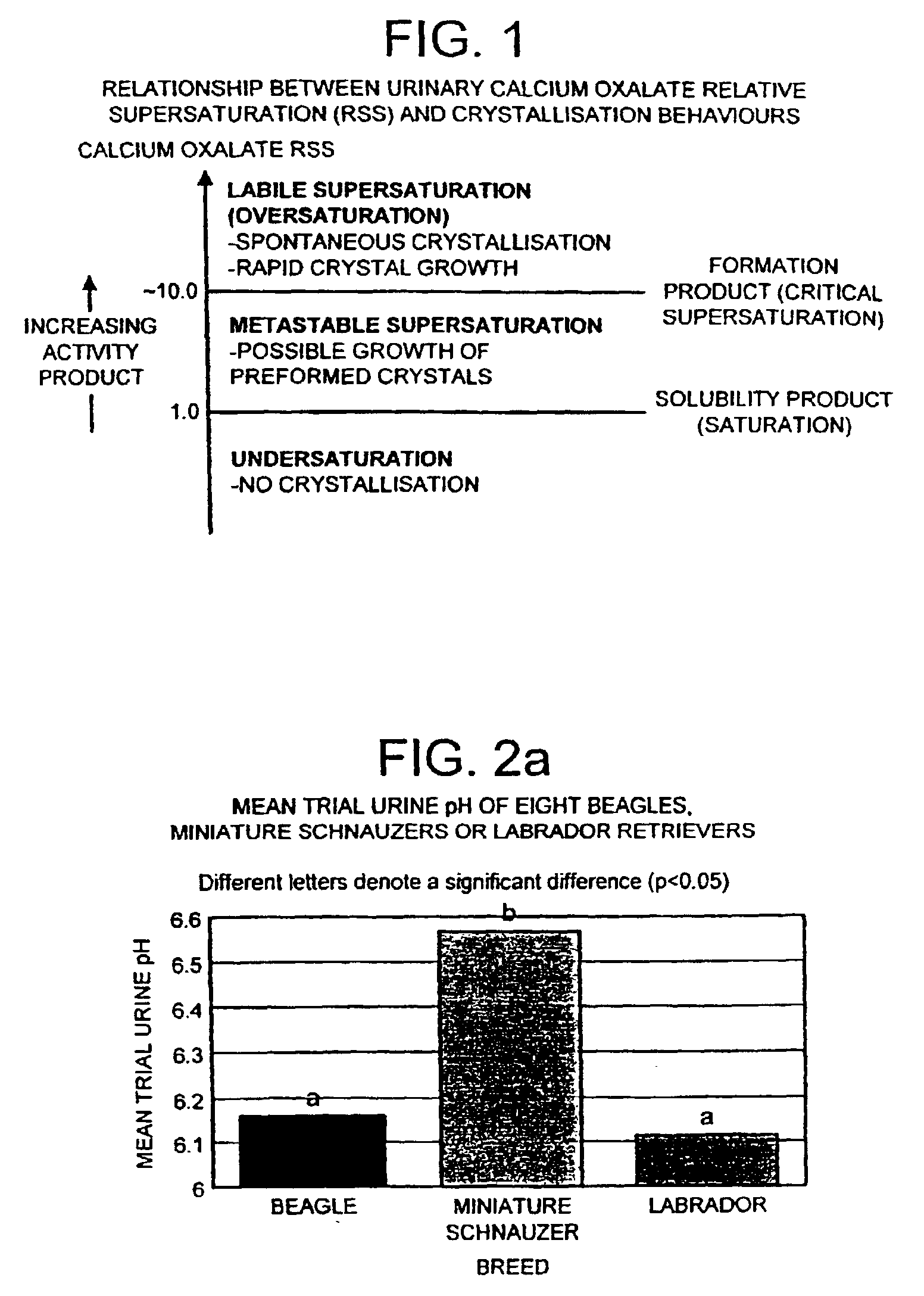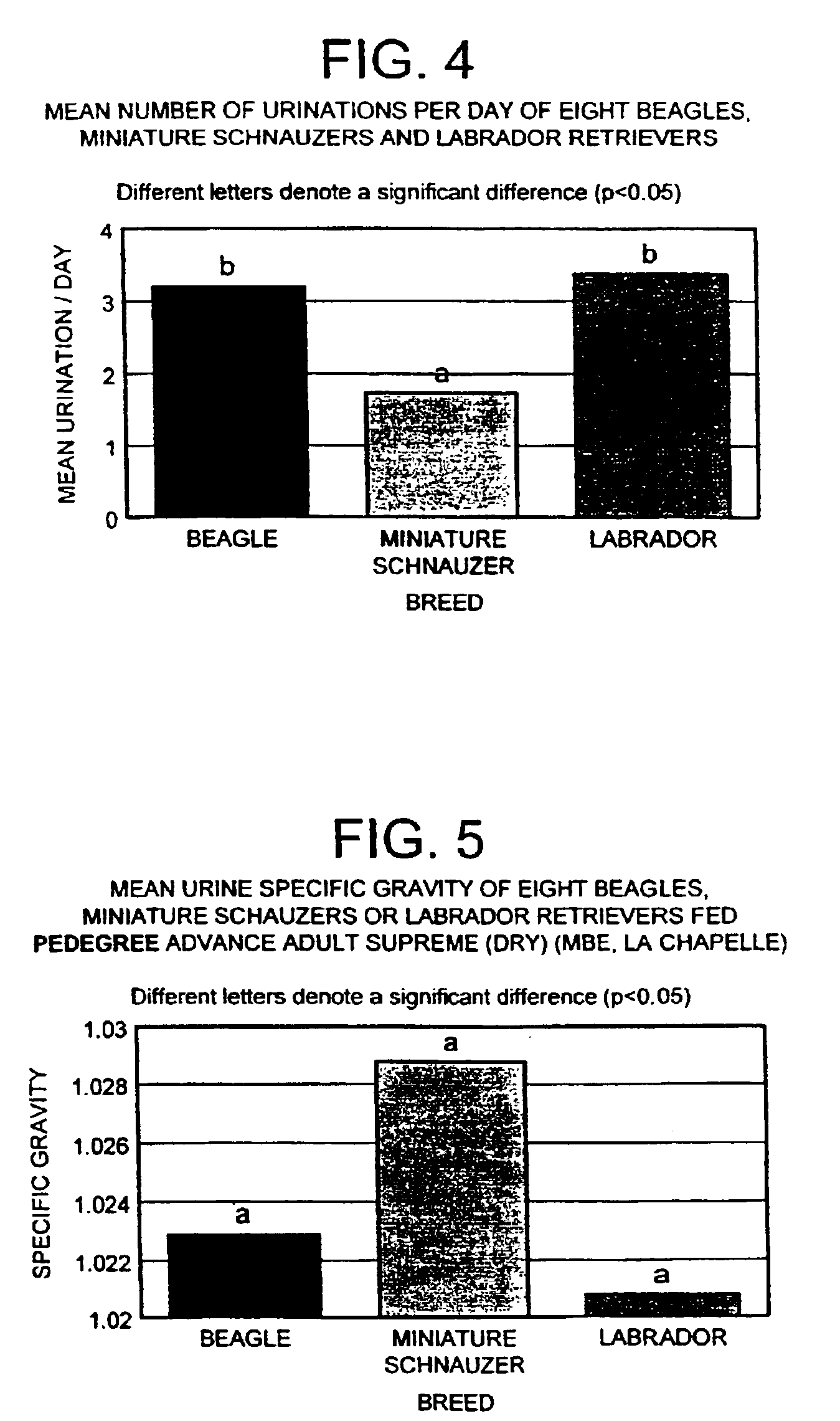Comestible for preventing calcium oxalate urolithiasis in canine animals
a technology of calcium oxalate urolithiasis and canine animals, which is applied in the field of canine animals, can solve the problems of an important, increasingly alkaline environment in the urine of urolithiasis, and achieve the effects of reducing the risk of calcium oxalate formation, preventing and reducing the formation of calcium oxalate, and facilitating passag
- Summary
- Abstract
- Description
- Claims
- Application Information
AI Technical Summary
Benefits of technology
Problems solved by technology
Method used
Image
Examples
example 1
An investigation as to possible differences in urine composition between small and non-small canine breeds.
Do Miniature Schnauzers produce urine of different composition to that of Labrador Retrievers and Beagles, when fed the same dry diet?
A trial was conducted examining the differences in urine pH, urine volume and specific gravity, number of urinations per day, urinary relative supersaturations and excretion of urine analytes between Labrador Retrievers (LR), Miniature Schnauzers (MS) and Beagles (B). As previously mentioned, the MS is a breed identified as being predisposed to calcium oxalate formation.
Eight dogs of each breed were fed a standard commercial dry dog food for three weeks. The various nutrient profiles for calcium, phosphorus, magnesium, potassium and sodium for this dry dog food is as follows:
Nutrientg / 400 kcalCalcium1.52Phosphorus1.22Magnesium0.12Potassium0.79Sodium0.26Protein28.48Moisture7.33Fat17.74Ash8.61Nitrogen Free Extract44.10
Each individual urination was ...
example 2
Do Cairn Terriers (CT) produce urine of a different composition to that of Labrador Retrievers, when fed the same dry diet?
The data described in Example 1 provides a rationale for adult maintenance / senior dog diets designed to reduce the risk of calcium oxalate formation in healthy small dogs. However, to ensure that the increased risk of calcium oxalate urolithiasis applies to small dogs in general, a second breed of small dog, the Cairn terrier (CT) was screened. In the second trial, differences in urine pH, urine volume and specific gravity, number of urinations per day, urine relative supersaturations and excretion of urine analytes between Labrador Retrievers (LR) and Cairn Terriers were examined.
15 healthy dogs consisting of 8 LR (3 entire females, 1 neutered male and 4 neutered females; mean age 2.5±0.2 years) and 7 CT (5 neutered females, 2 neutered males; mean age 7.0±1.7 years) were fed a standard commercial dry Dog food once daily for 21 days. The various nutrient profile...
example 3
Canine urinary pH and RSS screening trials to determine performance in terms of urine specific gravity urine pH, RSS and nutrient profile.
A number of canine urine specific gravity, canine urinary pH and RSS screening trials were conducted to determine whether a specific nutrient profile could be designed for a diet for use in maintaining urinary tract health, in particular reducing the risk of calcium oxalate formation.
The results are shown in the following tables (3 & 4). All trials were conducted in mixed breed panels (Labrador Retrievers, Beagles and Miniature Schnauzers) of normal healthy adult dogs.
TABLE 3DRY DIETSUrinary relativesupersaturationNutrients ( / 400 kcal)TrialCalciumUrine SpecificCalciumPhosphorusMagnesiumPotassiumSodiumProteinNoOxalateGravity(g)(g)(g)(g)(g)(g)11.03 ± 0.85a—0.880.70.110.750.5829.2727.31 ± 6.60c—1.571.220.110.70.2531.8733.84 ± 1.62abc1.033 ± 0.0091.291.020.070.510.6734.1645.92 ± 2.59bc1.025 ± 0.0121.781.190.10.760.228.2752.84 ± 1.63ab1.022 ± 0.0100.8...
PUM
 Login to View More
Login to View More Abstract
Description
Claims
Application Information
 Login to View More
Login to View More - R&D
- Intellectual Property
- Life Sciences
- Materials
- Tech Scout
- Unparalleled Data Quality
- Higher Quality Content
- 60% Fewer Hallucinations
Browse by: Latest US Patents, China's latest patents, Technical Efficacy Thesaurus, Application Domain, Technology Topic, Popular Technical Reports.
© 2025 PatSnap. All rights reserved.Legal|Privacy policy|Modern Slavery Act Transparency Statement|Sitemap|About US| Contact US: help@patsnap.com



